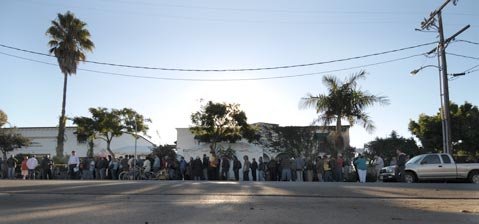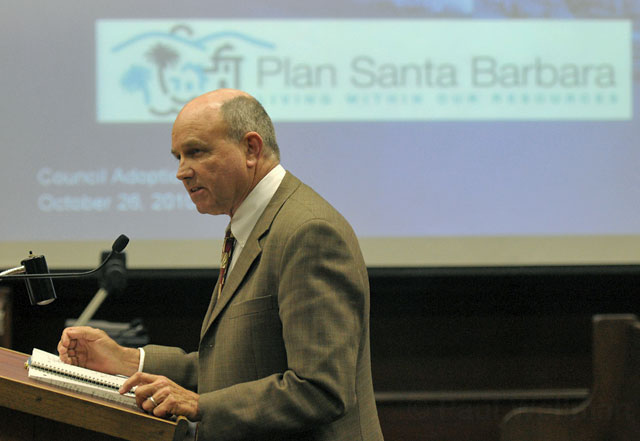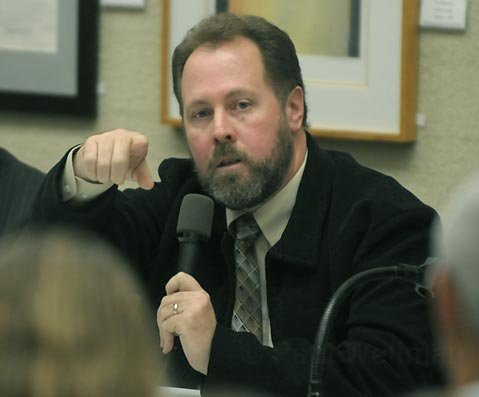Homeless Shelter Permit Can’t Be Touched
Casa Critics Get Much Sympathy, No Action

Efforts to reopen the conditional use permit for the Casa Esperanza homeless shelter to impose stricter limitations on shelter operations were dealt what appears to be a decisive setback, as Assistant City Attorney Scott Vincent notified members of the Santa Barbara Planning Commission there are no legal grounds to do so.
Members of the newly formed Milpas Community Association (MCA) have been waging a spirited campaign to reopen the permit conditions arguing that the shelter — which accepts up to 200 people a night during winter nights — has become an attractive nuisance, drawing aggressive panhandlers, street drunks, and vagrants. Thursday’s was the second major public hearing on the matter in three weeks. In the first, standing-room-only crowds packed City Hall, allowing the shelter’s supporters and detractors to provide the planners with what turned out to be vivid and impassioned testimony. Last Saturday, the MCA organized a march of about 150 people intent “on taking their neighborhood back” up State Street to De la Guerra Plaza. (Their stated concern was as much gang violence and pot shops as it was street crime associated with the homeless.)
While the planning commissioners clearly understood that lower Milpas Street — where the shelter is located — is experiencing more than its fair share of problems, not all of them were convinced that those problems could be blamed on the shelter itself. And legally, they stated, there was nothing city legal advisers said they could do. Scott Vincent argued that the time to challenge the conditional use permit was when it was first issued more than 10 years ago. Since then, Casa has invested $6 million based on the issuance of that permit. Only by demonstrating that the shelter violated the conditions of approval could the permit be revoked; to date, city planners charged with monitoring Casa operations are emphatic that the shelter is in compliance.
Of all the commissioners, Michael Jordan expressed the most interest in changing the conditions. He argued it defied common sense that planners today could not respond to circumstances unforeseen by the planners who first approved Casa. But Jordan insisted he was not interested in revoking the shelter’s permit — or even diminishing its mission. But he pressed Vincent about imposing tougher new requirements so that the shelter mitigate its impacts on the surrounding neighborhood more fully. “Any path will be challenging,” said Vincent, prompting Jordan to respond, “I feel like a dog chasing his tail.”

The other commissioners found themselves caught in a crossfire of conflicting sympathies. On one hand, they all expressed admiration for the work done by Casa Esperanza; on the other, they recognized that lower Milpas business owners had their hands full. Frustrated by their inability to do anything, the commissioners soliloquized at length. The problem, they agreed, was way bigger than the shelter; it as bigger than lower Milpas Street and it was bigger than the City of Santa Barbara. Commissioner John Jostes gave a rhetorical back-of-his-hand to what he termed “opportunistic vagrants who come to Santa Barbara to get something for nothing.” These people, he said, were distinct from the local poor who needed to be helped. “This is a regional issue and we can’t solve it at the local level,” he said. Goleta, the County of Santa Barbara, Carpinteria, and Coast Village Road all needed to step up to assume their fair share of the burden imposed by the estimated 1,000 homeless people now living on the South Coast.
Commissioner Stella Larson said, “We can’t end it, but we can help it,” adding, “But it has to be in a circle. It has to be win-win-win.” Deborah Schwartz likewise embraced the regional nature of the problem, but insisted that Santa Barbara could not shy away from its leadership of providing shelter to the homeless. “If we turn away from our humanitarianism, then what’s to become of our community?” she asked. Commissioner Jordan took the county government to task for not doing enough, stating, “I think it’s time to offend the county. The county needs to be offended. The conversation should be unpleasant.” Jostes shot back, “There’s not a government solution here. Government can’t solve this problem. It’s much bigger than that.” Larson jumped back with, “It’s not a government problem, it’s a community problem,” adding, “but it’s all the communities’ problem.”
At this point, representatives of the Milpas Community Association began shifting uncomfortably in their seats. Despite the outpouring of generalities and hand-wringing by the commissioners, some specific suggestions were made. The police should step up foot patrol or bike patrol; they should consider reinstituting the street hosts who used to roam State Street attired in shorts, polo shorts, and pith helmets to reassure tourists and residents who might feel importuned by unruly street people. The shelter itself was urged to increase the number of people assigned to its “Step-Up” neighborhood patrol. Currently, there are four. “You need to supersize that,” said Jostes.

Likewise, shelter operators were asked to pursue mobile food vans for feeding the poor. Currently, the shelter provides free hot cooked lunches to about 150 people a day, only 50 of whom are enrolled in shelter programs. Many Milpas residents contend that some of those people are drawn to the neighborhood by the offer of a free lunch, and then they hang out at the Cabrillo Ball Field, get stoned, and harass passersby. Casa executive Mike Foley took exception to this suggestion, stating that the shelter handled only 200 homeless a night, only 20 percent of the estimated homeless population. He has offered to discontinue the shelter’s free lunch program only when substitute quarters are secured.
He estimated that as many as 25 percent of the free lunch recipients weren’t homeless at all, just poor and hungry. In previous meetings, Foley marshaled support from the local clergy to testify on behalf of the shelter and the lunch program. Commissioner Jordan took exception to that, stating, “I’m really frustrated by some of the rhetoric,” he said. “The faith community can no longer hide behind the shield of compassion and ignore what’s going on in the neighborhoods.” Foley has insisted that the free lunch program has been an essential tool for bringing homeless people otherwise too suspicious of service providers to come in from the cold. Without it, he said, many homeless would never have agreed to get the services that ultimately helped them get clean, sober, and housed.
There was much discussion and debate over crime statistics recently released by the police department indicating that homeless street crime in the lower Milpas neighborhood had shot up 472 percent since the shelter opened, compared to 22 percent throughout the rest of the city. Commissioners Schwartz and Bartlett in particular chipped away at the basis, getting Police Captain Alex Altavilla to acknowledge that he had no way of knowing that all these crimes had in fact been committed by homeless people or to what extent gang members might have had a hand in some of the vandalism reported. Altavilla acknowledged that when police officers are dispatched to a problem area — as they have been in the lower Milpas area — the number of reported contacts increases dramatically. “The way these statistics are put together, I think is misleading,” stated Bartlett. “All your concerns are very well taken,” agreed Altavilla.
Foley noted that until 2008, city police gave Casa monthly crime reports, which he used as the basis for devising anti-crime response strategies. He claimed he’d been able to reduce crime by 25-35 percent using those statistical reports. Because of budget cuts, the police have fewer personnel assigned to crime statistics and that program stopped. Likewise, he said, the now defunct Milpas Business Association went belly-up, leaving him — and the neighborhood — without a valuable ally to keep the streets safe. Bartlett argued that many of the street crime problems plaguing Lower Milpas have causes other than the shelter.
But whatever the correct statistical measure of the problem, the solution will cost money. And with city hall still in the throes of a chronic budget shortfall, it’s doubtful there will be much for an increased police presence. At one point, members of the Milpas Community Association were told they might need to pony up the money to pay part of the salary for a beat officer. The Downtown Organization, eager to rid State Street of homeless, agreed to pay half the salary of a retired police officer to walk patrol. But that officer, Bob Casey, decided to retire for good this past July and has not been replaced since.
In the meantime, Mayor Helene Schneider has proposed reviving the ad hoc subcommittee that crafted the 12-point program to deal with homelessness. This group would study, among other things, the shelter’s free lunch program, any alternatives that might exist, and the extent of hunger on the South Coast. Commissioner Jordan, who served on the committee that drafted the 12-point plan, said he was pessimistic. No one will participate, he said, unless there’s some hope at the end that there will be a workable plan to achieve some real relief. The City Council will discuss that plan this Tuesday.



